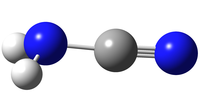|
Cyanamide tunnels between two equivalent
positions, just as ammonia does.
The experimental data within each tunneling state
have been summarized by
(1) Z. Kisiel, A. Krasnicki, W. Jabs, E. Herbst,
B. P. Winnewisser, and M. Winnewisser,
2013, J. Phys. Chem. A, 117, 9889.
By far the most lines are from that work. Few lines
originate from
(2) J. K. Tyler, J. Sheridan, and C. C. Costain,
1972, J. Mol. Spectrosc., 43, 248;
and from
(3) R. D. Brown, P. D. Godfrey, M. Head-Gordon,
K. Wiedenmann, and B. Kleibömer,
1988, J. Mol. Spectrosc., 130, 213.
The present parameter set differs slightly from that in (1).
The experimental transition frequencies were reproduced
slightly outside the reported uncertainties. This is
likely more an issue of unaccounted perturbations rather
than too optimistic uncertainties. The a-type
transitions are within tunneling states whereas the
c-type transitions connect the two tunneling states.
The predictions should be sufficiently accurate for all
astronomical observaitions, but should be viewed with caution
once the predicted uncertainties exceed 0.3 MHz.
The dipole moment components were assumed to agree
with those of the main isotopolog:
(4) W. G. Read, E. A. Cohen, and H. M. Pickett,
1986, J. Mol. Spectrosc., 115, 316.
|
